Intercultural Competence in Business: A Comparison of Romanian and Spanish Culture
VerifiedAdded on 2023/06/10
|9
|2294
|331
AI Summary
This report compares Romanian and Spanish culture using Kluckhohn and Strodtbeck’s and Hall Edward theory. It includes autobiographies, cultural norms, values, beliefs, and language. The report concludes that intercultural competence is essential for business success.
Contribute Materials
Your contribution can guide someone’s learning journey. Share your
documents today.

Intercultural
Competence in
Business
Table of Contents
Competence in
Business
Table of Contents
Secure Best Marks with AI Grader
Need help grading? Try our AI Grader for instant feedback on your assignments.

INTRODUCTION...........................................................................................................................3
TASK...............................................................................................................................................3
Autobiography of X.....................................................................................................................3
Autobiography of Y.....................................................................................................................4
Comparison between Romanian culture and Spanish culture.....................................................5
Link both Romanian and Spanish culture with theories..............................................................6
CONCLUSION................................................................................................................................8
REFERENCES................................................................................................................................9
TASK...............................................................................................................................................3
Autobiography of X.....................................................................................................................3
Autobiography of Y.....................................................................................................................4
Comparison between Romanian culture and Spanish culture.....................................................5
Link both Romanian and Spanish culture with theories..............................................................6
CONCLUSION................................................................................................................................8
REFERENCES................................................................................................................................9

INTRODUCTION
Every country is having different set of culture, belief and tradition that makes it unique in its
own way. Culture and tradition makes the country different from each other. It helps in providing
the intrinsic value in terms of social and economic benefits (Murphie and Potts, 2017). There are
various benefits that a culture has. This project report will cover a vast comparison of Romanian
and Spanish culture along with its theories in order to demonstrate the differences and
similarities by using different theories. This project report will cover Kluckhohn and Strodbeck’s
and Hall Edward theory. In addition to that, it will also include the analysis of both the person
based on theories.
TASK
Autobiography of X
X is a 16 year old boy lives in Oradea, Romania. As he was living with his parents in Romania
since his birth that becomes quite easy for him to adopt the culture of this country. He was aware
about all the culture and tradition of country. It becomes easy for him to adopt as his parents
were living in the same country since their childhood. They have provided detailed explanation
about the tradition and culture of Romanian. Their parents told him the stories of Romanian
emperor that makes him about the culture more deeply. The Romania was in three regions
Walachia, Moldavia, and Transylvania. The books of Romania also tell students about the past
foreign occupation. The boy got to know about the that there are various regions that was ruled
by different people. Each part of the country is divided into three parts and having different set of
culture and tradition. The three parts of Romania are East, West and South. Molodova is situated
in the middle of east part. In the west part adjacent regions are situated. There are different set of
traditions that the boy has learned through his parents. As there are two communities in
Romania; Hungarian and German community.
Language – The people of Romania speaks the Romanian and around 7% populations
speaks Hungarian. In addition to that, around 1.5% people speak German.
Society –The Romanian is the hierarchical society in which age and position are being
respected. The older people are viewed in the sense and have much experience as they
Every country is having different set of culture, belief and tradition that makes it unique in its
own way. Culture and tradition makes the country different from each other. It helps in providing
the intrinsic value in terms of social and economic benefits (Murphie and Potts, 2017). There are
various benefits that a culture has. This project report will cover a vast comparison of Romanian
and Spanish culture along with its theories in order to demonstrate the differences and
similarities by using different theories. This project report will cover Kluckhohn and Strodbeck’s
and Hall Edward theory. In addition to that, it will also include the analysis of both the person
based on theories.
TASK
Autobiography of X
X is a 16 year old boy lives in Oradea, Romania. As he was living with his parents in Romania
since his birth that becomes quite easy for him to adopt the culture of this country. He was aware
about all the culture and tradition of country. It becomes easy for him to adopt as his parents
were living in the same country since their childhood. They have provided detailed explanation
about the tradition and culture of Romanian. Their parents told him the stories of Romanian
emperor that makes him about the culture more deeply. The Romania was in three regions
Walachia, Moldavia, and Transylvania. The books of Romania also tell students about the past
foreign occupation. The boy got to know about the that there are various regions that was ruled
by different people. Each part of the country is divided into three parts and having different set of
culture and tradition. The three parts of Romania are East, West and South. Molodova is situated
in the middle of east part. In the west part adjacent regions are situated. There are different set of
traditions that the boy has learned through his parents. As there are two communities in
Romania; Hungarian and German community.
Language – The people of Romania speaks the Romanian and around 7% populations
speaks Hungarian. In addition to that, around 1.5% people speak German.
Society –The Romanian is the hierarchical society in which age and position are being
respected. The older people are viewed in the sense and have much experience as they
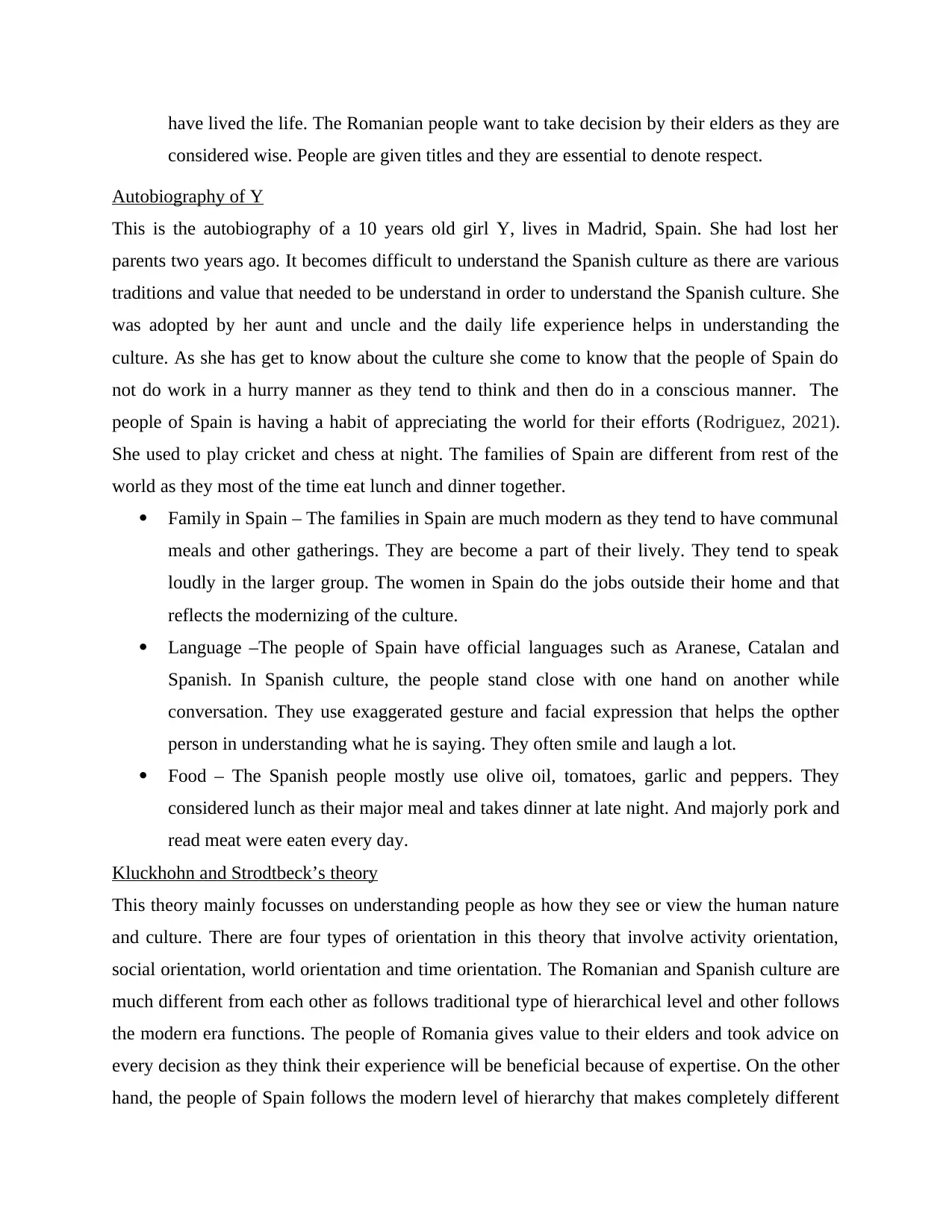
have lived the life. The Romanian people want to take decision by their elders as they are
considered wise. People are given titles and they are essential to denote respect.
Autobiography of Y
This is the autobiography of a 10 years old girl Y, lives in Madrid, Spain. She had lost her
parents two years ago. It becomes difficult to understand the Spanish culture as there are various
traditions and value that needed to be understand in order to understand the Spanish culture. She
was adopted by her aunt and uncle and the daily life experience helps in understanding the
culture. As she has get to know about the culture she come to know that the people of Spain do
not do work in a hurry manner as they tend to think and then do in a conscious manner. The
people of Spain is having a habit of appreciating the world for their efforts (Rodriguez, 2021).
She used to play cricket and chess at night. The families of Spain are different from rest of the
world as they most of the time eat lunch and dinner together.
Family in Spain – The families in Spain are much modern as they tend to have communal
meals and other gatherings. They are become a part of their lively. They tend to speak
loudly in the larger group. The women in Spain do the jobs outside their home and that
reflects the modernizing of the culture.
Language –The people of Spain have official languages such as Aranese, Catalan and
Spanish. In Spanish culture, the people stand close with one hand on another while
conversation. They use exaggerated gesture and facial expression that helps the opther
person in understanding what he is saying. They often smile and laugh a lot.
Food – The Spanish people mostly use olive oil, tomatoes, garlic and peppers. They
considered lunch as their major meal and takes dinner at late night. And majorly pork and
read meat were eaten every day.
Kluckhohn and Strodtbeck’s theory
This theory mainly focusses on understanding people as how they see or view the human nature
and culture. There are four types of orientation in this theory that involve activity orientation,
social orientation, world orientation and time orientation. The Romanian and Spanish culture are
much different from each other as follows traditional type of hierarchical level and other follows
the modern era functions. The people of Romania gives value to their elders and took advice on
every decision as they think their experience will be beneficial because of expertise. On the other
hand, the people of Spain follows the modern level of hierarchy that makes completely different
considered wise. People are given titles and they are essential to denote respect.
Autobiography of Y
This is the autobiography of a 10 years old girl Y, lives in Madrid, Spain. She had lost her
parents two years ago. It becomes difficult to understand the Spanish culture as there are various
traditions and value that needed to be understand in order to understand the Spanish culture. She
was adopted by her aunt and uncle and the daily life experience helps in understanding the
culture. As she has get to know about the culture she come to know that the people of Spain do
not do work in a hurry manner as they tend to think and then do in a conscious manner. The
people of Spain is having a habit of appreciating the world for their efforts (Rodriguez, 2021).
She used to play cricket and chess at night. The families of Spain are different from rest of the
world as they most of the time eat lunch and dinner together.
Family in Spain – The families in Spain are much modern as they tend to have communal
meals and other gatherings. They are become a part of their lively. They tend to speak
loudly in the larger group. The women in Spain do the jobs outside their home and that
reflects the modernizing of the culture.
Language –The people of Spain have official languages such as Aranese, Catalan and
Spanish. In Spanish culture, the people stand close with one hand on another while
conversation. They use exaggerated gesture and facial expression that helps the opther
person in understanding what he is saying. They often smile and laugh a lot.
Food – The Spanish people mostly use olive oil, tomatoes, garlic and peppers. They
considered lunch as their major meal and takes dinner at late night. And majorly pork and
read meat were eaten every day.
Kluckhohn and Strodtbeck’s theory
This theory mainly focusses on understanding people as how they see or view the human nature
and culture. There are four types of orientation in this theory that involve activity orientation,
social orientation, world orientation and time orientation. The Romanian and Spanish culture are
much different from each other as follows traditional type of hierarchical level and other follows
the modern era functions. The people of Romania gives value to their elders and took advice on
every decision as they think their experience will be beneficial because of expertise. On the other
hand, the people of Spain follows the modern level of hierarchy that makes completely different
Secure Best Marks with AI Grader
Need help grading? Try our AI Grader for instant feedback on your assignments.
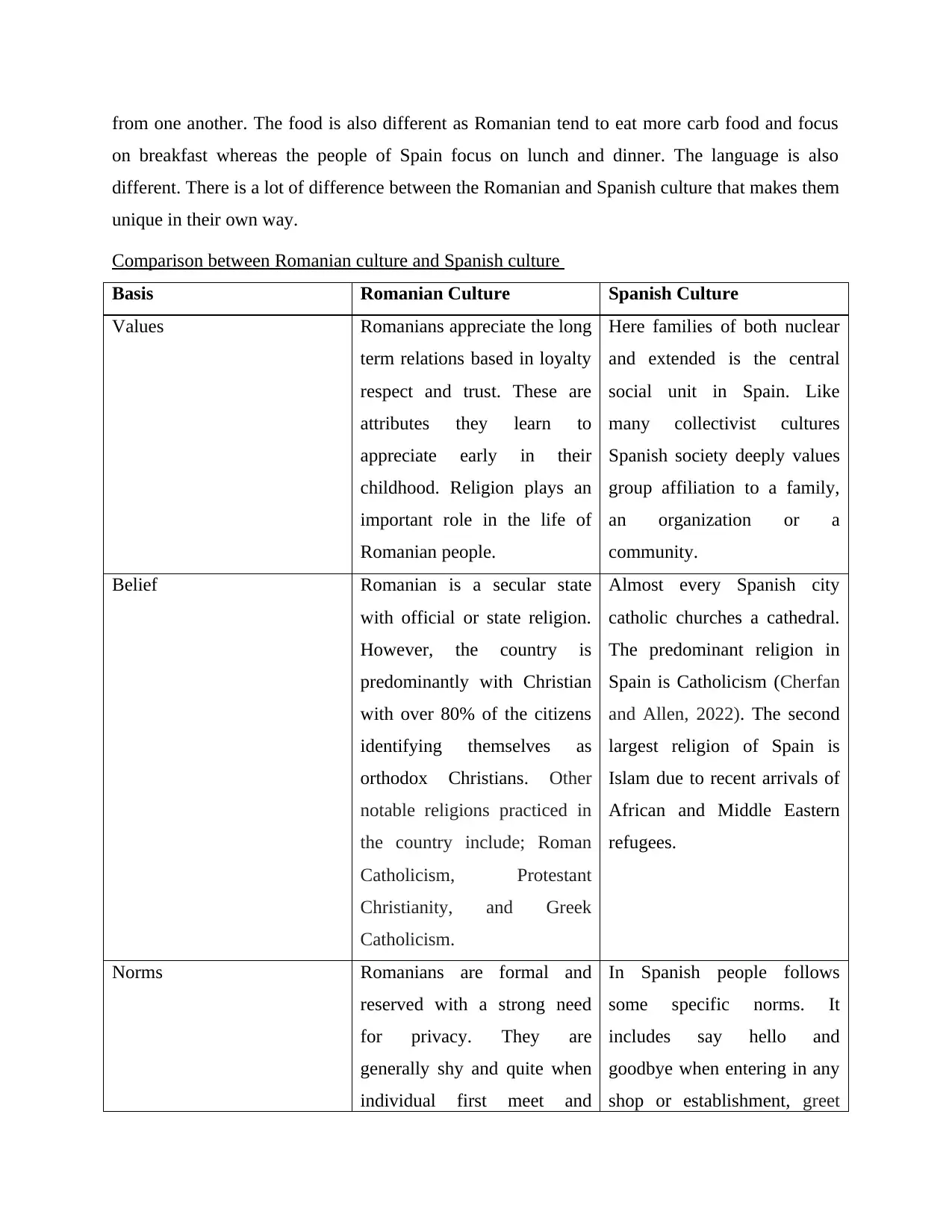
from one another. The food is also different as Romanian tend to eat more carb food and focus
on breakfast whereas the people of Spain focus on lunch and dinner. The language is also
different. There is a lot of difference between the Romanian and Spanish culture that makes them
unique in their own way.
Comparison between Romanian culture and Spanish culture
Basis Romanian Culture Spanish Culture
Values Romanians appreciate the long
term relations based in loyalty
respect and trust. These are
attributes they learn to
appreciate early in their
childhood. Religion plays an
important role in the life of
Romanian people.
Here families of both nuclear
and extended is the central
social unit in Spain. Like
many collectivist cultures
Spanish society deeply values
group affiliation to a family,
an organization or a
community.
Belief Romanian is a secular state
with official or state religion.
However, the country is
predominantly with Christian
with over 80% of the citizens
identifying themselves as
orthodox Christians. Other
notable religions practiced in
the country include; Roman
Catholicism, Protestant
Christianity, and Greek
Catholicism.
Almost every Spanish city
catholic churches a cathedral.
The predominant religion in
Spain is Catholicism (Cherfan
and Allen, 2022). The second
largest religion of Spain is
Islam due to recent arrivals of
African and Middle Eastern
refugees.
Norms Romanians are formal and
reserved with a strong need
for privacy. They are
generally shy and quite when
individual first meet and
In Spanish people follows
some specific norms. It
includes say hello and
goodbye when entering in any
shop or establishment, greet
on breakfast whereas the people of Spain focus on lunch and dinner. The language is also
different. There is a lot of difference between the Romanian and Spanish culture that makes them
unique in their own way.
Comparison between Romanian culture and Spanish culture
Basis Romanian Culture Spanish Culture
Values Romanians appreciate the long
term relations based in loyalty
respect and trust. These are
attributes they learn to
appreciate early in their
childhood. Religion plays an
important role in the life of
Romanian people.
Here families of both nuclear
and extended is the central
social unit in Spain. Like
many collectivist cultures
Spanish society deeply values
group affiliation to a family,
an organization or a
community.
Belief Romanian is a secular state
with official or state religion.
However, the country is
predominantly with Christian
with over 80% of the citizens
identifying themselves as
orthodox Christians. Other
notable religions practiced in
the country include; Roman
Catholicism, Protestant
Christianity, and Greek
Catholicism.
Almost every Spanish city
catholic churches a cathedral.
The predominant religion in
Spain is Catholicism (Cherfan
and Allen, 2022). The second
largest religion of Spain is
Islam due to recent arrivals of
African and Middle Eastern
refugees.
Norms Romanians are formal and
reserved with a strong need
for privacy. They are
generally shy and quite when
individual first meet and
In Spanish people follows
some specific norms. It
includes say hello and
goodbye when entering in any
shop or establishment, greet
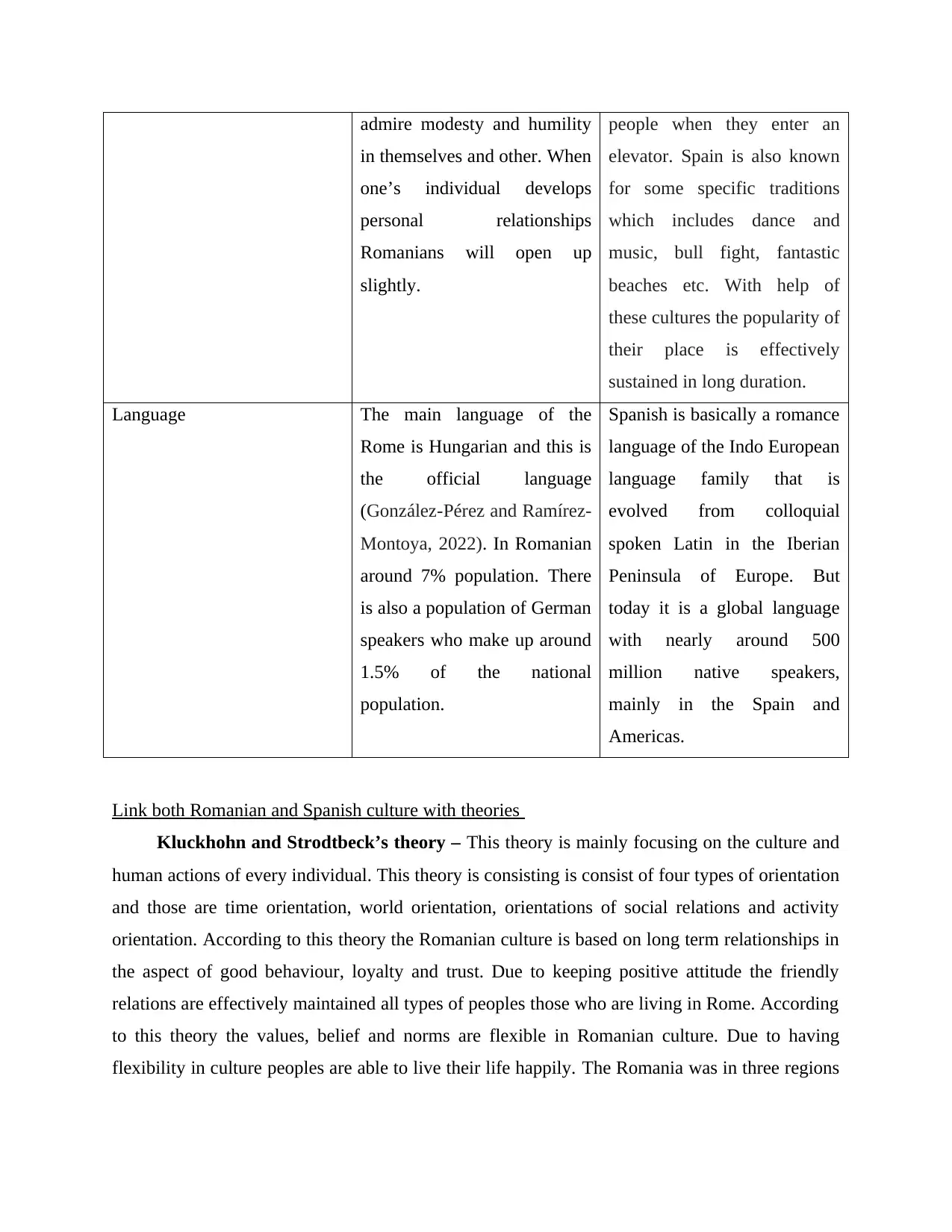
admire modesty and humility
in themselves and other. When
one’s individual develops
personal relationships
Romanians will open up
slightly.
people when they enter an
elevator. Spain is also known
for some specific traditions
which includes dance and
music, bull fight, fantastic
beaches etc. With help of
these cultures the popularity of
their place is effectively
sustained in long duration.
Language The main language of the
Rome is Hungarian and this is
the official language
(González-Pérez and Ramírez-
Montoya, 2022). In Romanian
around 7% population. There
is also a population of German
speakers who make up around
1.5% of the national
population.
Spanish is basically a romance
language of the Indo European
language family that is
evolved from colloquial
spoken Latin in the Iberian
Peninsula of Europe. But
today it is a global language
with nearly around 500
million native speakers,
mainly in the Spain and
Americas.
Link both Romanian and Spanish culture with theories
Kluckhohn and Strodtbeck’s theory – This theory is mainly focusing on the culture and
human actions of every individual. This theory is consisting is consist of four types of orientation
and those are time orientation, world orientation, orientations of social relations and activity
orientation. According to this theory the Romanian culture is based on long term relationships in
the aspect of good behaviour, loyalty and trust. Due to keeping positive attitude the friendly
relations are effectively maintained all types of peoples those who are living in Rome. According
to this theory the values, belief and norms are flexible in Romanian culture. Due to having
flexibility in culture peoples are able to live their life happily. The Romania was in three regions
in themselves and other. When
one’s individual develops
personal relationships
Romanians will open up
slightly.
people when they enter an
elevator. Spain is also known
for some specific traditions
which includes dance and
music, bull fight, fantastic
beaches etc. With help of
these cultures the popularity of
their place is effectively
sustained in long duration.
Language The main language of the
Rome is Hungarian and this is
the official language
(González-Pérez and Ramírez-
Montoya, 2022). In Romanian
around 7% population. There
is also a population of German
speakers who make up around
1.5% of the national
population.
Spanish is basically a romance
language of the Indo European
language family that is
evolved from colloquial
spoken Latin in the Iberian
Peninsula of Europe. But
today it is a global language
with nearly around 500
million native speakers,
mainly in the Spain and
Americas.
Link both Romanian and Spanish culture with theories
Kluckhohn and Strodtbeck’s theory – This theory is mainly focusing on the culture and
human actions of every individual. This theory is consisting is consist of four types of orientation
and those are time orientation, world orientation, orientations of social relations and activity
orientation. According to this theory the Romanian culture is based on long term relationships in
the aspect of good behaviour, loyalty and trust. Due to keeping positive attitude the friendly
relations are effectively maintained all types of peoples those who are living in Rome. According
to this theory the values, belief and norms are flexible in Romanian culture. Due to having
flexibility in culture peoples are able to live their life happily. The Romania was in three regions
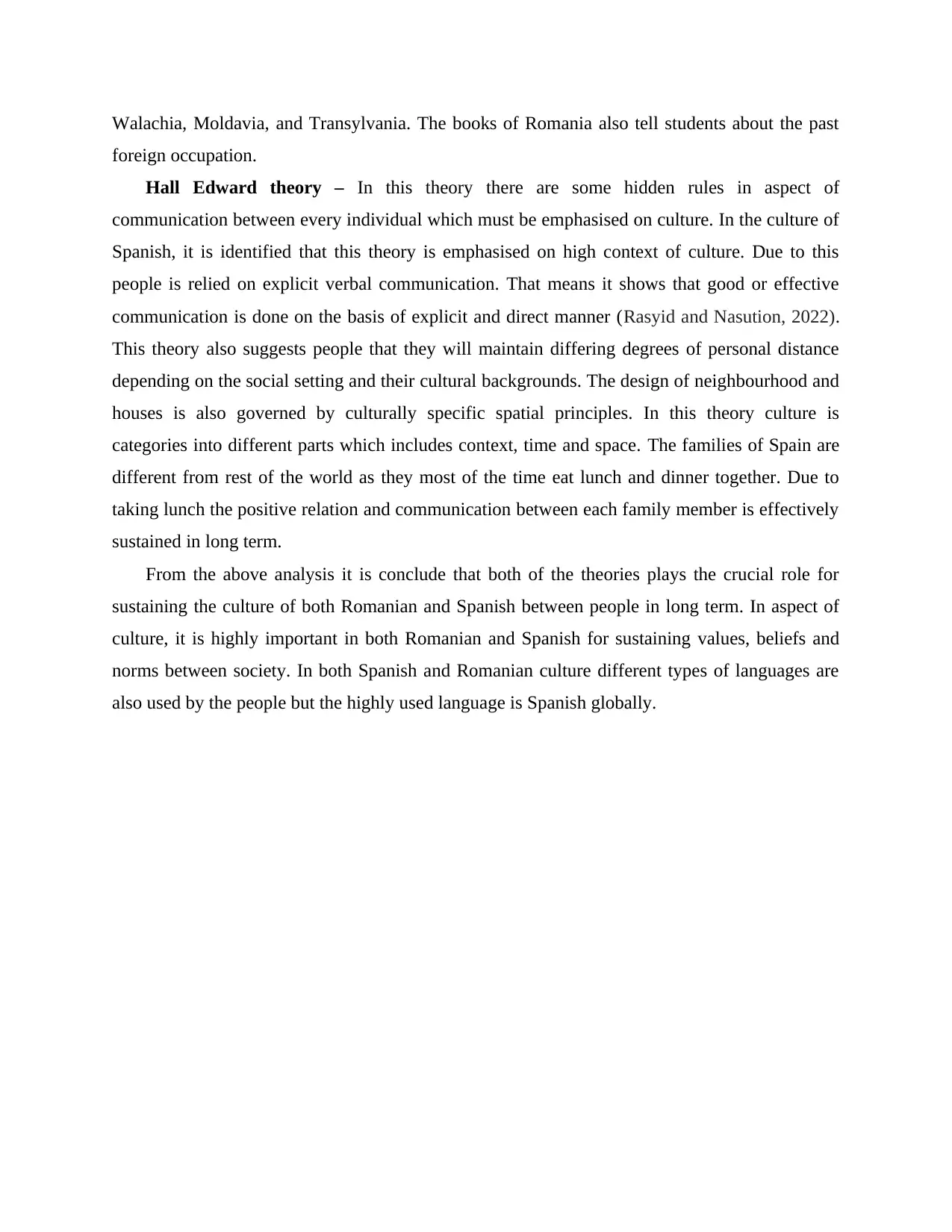
Walachia, Moldavia, and Transylvania. The books of Romania also tell students about the past
foreign occupation.
Hall Edward theory – In this theory there are some hidden rules in aspect of
communication between every individual which must be emphasised on culture. In the culture of
Spanish, it is identified that this theory is emphasised on high context of culture. Due to this
people is relied on explicit verbal communication. That means it shows that good or effective
communication is done on the basis of explicit and direct manner (Rasyid and Nasution, 2022).
This theory also suggests people that they will maintain differing degrees of personal distance
depending on the social setting and their cultural backgrounds. The design of neighbourhood and
houses is also governed by culturally specific spatial principles. In this theory culture is
categories into different parts which includes context, time and space. The families of Spain are
different from rest of the world as they most of the time eat lunch and dinner together. Due to
taking lunch the positive relation and communication between each family member is effectively
sustained in long term.
From the above analysis it is conclude that both of the theories plays the crucial role for
sustaining the culture of both Romanian and Spanish between people in long term. In aspect of
culture, it is highly important in both Romanian and Spanish for sustaining values, beliefs and
norms between society. In both Spanish and Romanian culture different types of languages are
also used by the people but the highly used language is Spanish globally.
foreign occupation.
Hall Edward theory – In this theory there are some hidden rules in aspect of
communication between every individual which must be emphasised on culture. In the culture of
Spanish, it is identified that this theory is emphasised on high context of culture. Due to this
people is relied on explicit verbal communication. That means it shows that good or effective
communication is done on the basis of explicit and direct manner (Rasyid and Nasution, 2022).
This theory also suggests people that they will maintain differing degrees of personal distance
depending on the social setting and their cultural backgrounds. The design of neighbourhood and
houses is also governed by culturally specific spatial principles. In this theory culture is
categories into different parts which includes context, time and space. The families of Spain are
different from rest of the world as they most of the time eat lunch and dinner together. Due to
taking lunch the positive relation and communication between each family member is effectively
sustained in long term.
From the above analysis it is conclude that both of the theories plays the crucial role for
sustaining the culture of both Romanian and Spanish between people in long term. In aspect of
culture, it is highly important in both Romanian and Spanish for sustaining values, beliefs and
norms between society. In both Spanish and Romanian culture different types of languages are
also used by the people but the highly used language is Spanish globally.
Paraphrase This Document
Need a fresh take? Get an instant paraphrase of this document with our AI Paraphraser
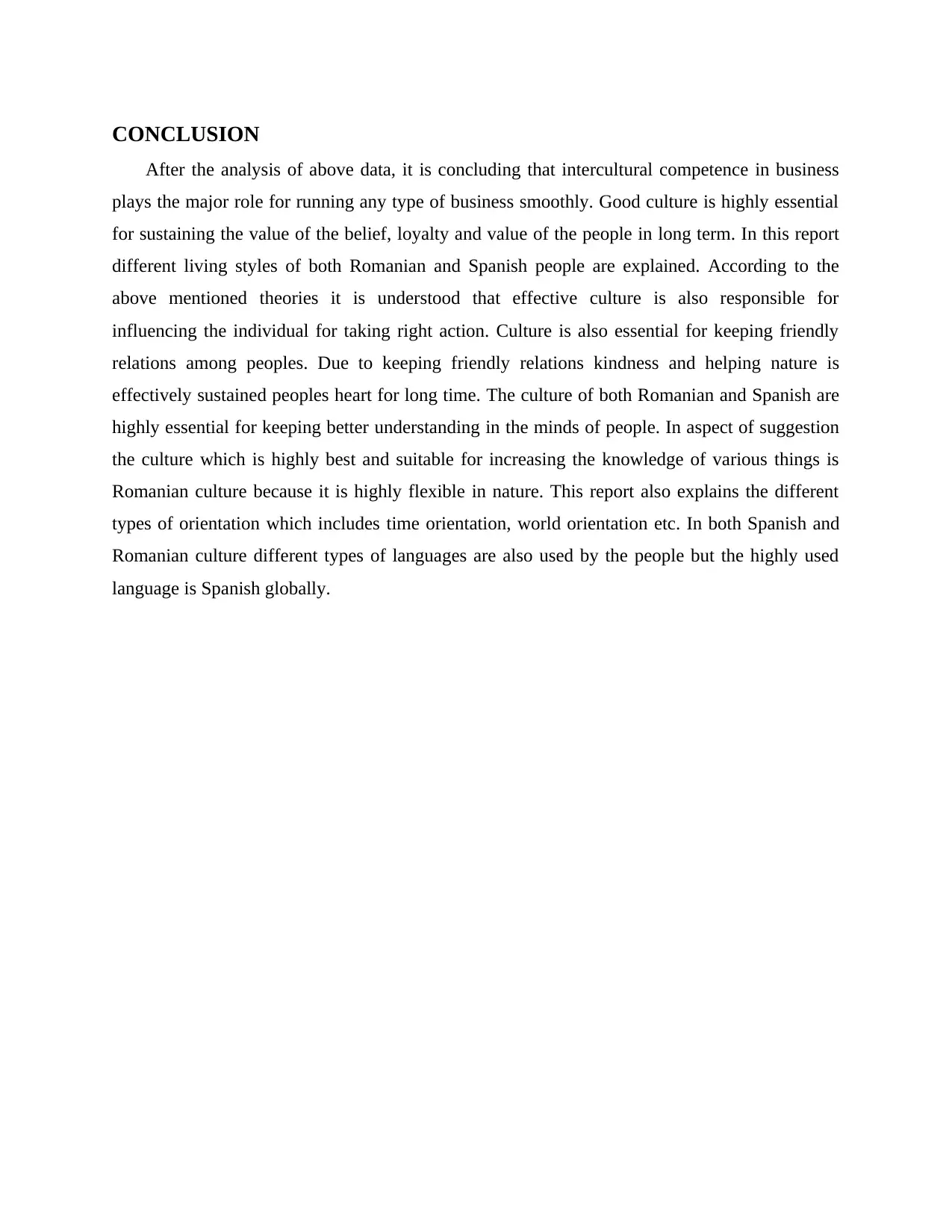
CONCLUSION
After the analysis of above data, it is concluding that intercultural competence in business
plays the major role for running any type of business smoothly. Good culture is highly essential
for sustaining the value of the belief, loyalty and value of the people in long term. In this report
different living styles of both Romanian and Spanish people are explained. According to the
above mentioned theories it is understood that effective culture is also responsible for
influencing the individual for taking right action. Culture is also essential for keeping friendly
relations among peoples. Due to keeping friendly relations kindness and helping nature is
effectively sustained peoples heart for long time. The culture of both Romanian and Spanish are
highly essential for keeping better understanding in the minds of people. In aspect of suggestion
the culture which is highly best and suitable for increasing the knowledge of various things is
Romanian culture because it is highly flexible in nature. This report also explains the different
types of orientation which includes time orientation, world orientation etc. In both Spanish and
Romanian culture different types of languages are also used by the people but the highly used
language is Spanish globally.
After the analysis of above data, it is concluding that intercultural competence in business
plays the major role for running any type of business smoothly. Good culture is highly essential
for sustaining the value of the belief, loyalty and value of the people in long term. In this report
different living styles of both Romanian and Spanish people are explained. According to the
above mentioned theories it is understood that effective culture is also responsible for
influencing the individual for taking right action. Culture is also essential for keeping friendly
relations among peoples. Due to keeping friendly relations kindness and helping nature is
effectively sustained peoples heart for long time. The culture of both Romanian and Spanish are
highly essential for keeping better understanding in the minds of people. In aspect of suggestion
the culture which is highly best and suitable for increasing the knowledge of various things is
Romanian culture because it is highly flexible in nature. This report also explains the different
types of orientation which includes time orientation, world orientation etc. In both Spanish and
Romanian culture different types of languages are also used by the people but the highly used
language is Spanish globally.
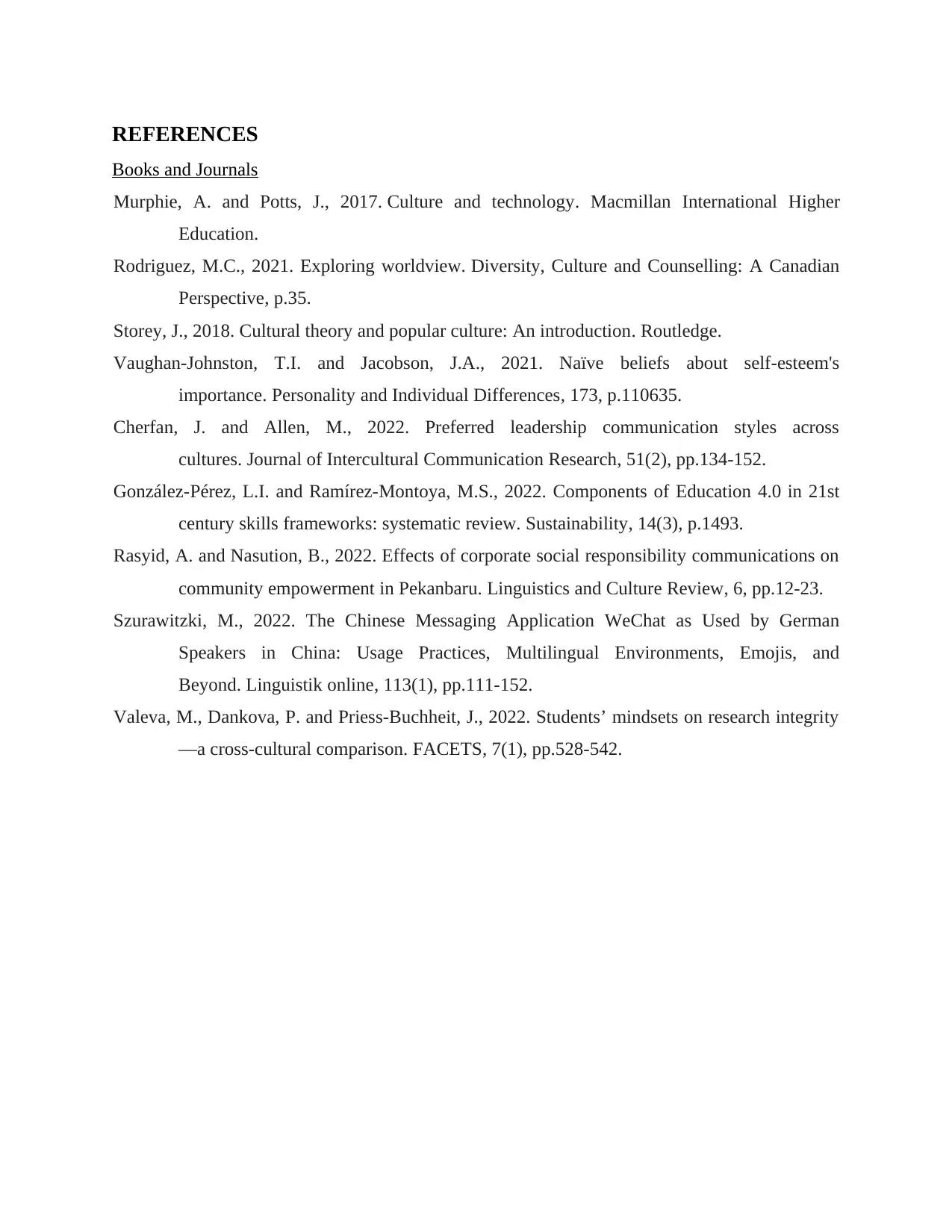
REFERENCES
Books and Journals
Murphie, A. and Potts, J., 2017. Culture and technology. Macmillan International Higher
Education.
Rodriguez, M.C., 2021. Exploring worldview. Diversity, Culture and Counselling: A Canadian
Perspective, p.35.
Storey, J., 2018. Cultural theory and popular culture: An introduction. Routledge.
Vaughan-Johnston, T.I. and Jacobson, J.A., 2021. Naïve beliefs about self-esteem's
importance. Personality and Individual Differences, 173, p.110635.
Cherfan, J. and Allen, M., 2022. Preferred leadership communication styles across
cultures. Journal of Intercultural Communication Research, 51(2), pp.134-152.
González-Pérez, L.I. and Ramírez-Montoya, M.S., 2022. Components of Education 4.0 in 21st
century skills frameworks: systematic review. Sustainability, 14(3), p.1493.
Rasyid, A. and Nasution, B., 2022. Effects of corporate social responsibility communications on
community empowerment in Pekanbaru. Linguistics and Culture Review, 6, pp.12-23.
Szurawitzki, M., 2022. The Chinese Messaging Application WeChat as Used by German
Speakers in China: Usage Practices, Multilingual Environments, Emojis, and
Beyond. Linguistik online, 113(1), pp.111-152.
Valeva, M., Dankova, P. and Priess-Buchheit, J., 2022. Students’ mindsets on research integrity
—a cross-cultural comparison. FACETS, 7(1), pp.528-542.
Books and Journals
Murphie, A. and Potts, J., 2017. Culture and technology. Macmillan International Higher
Education.
Rodriguez, M.C., 2021. Exploring worldview. Diversity, Culture and Counselling: A Canadian
Perspective, p.35.
Storey, J., 2018. Cultural theory and popular culture: An introduction. Routledge.
Vaughan-Johnston, T.I. and Jacobson, J.A., 2021. Naïve beliefs about self-esteem's
importance. Personality and Individual Differences, 173, p.110635.
Cherfan, J. and Allen, M., 2022. Preferred leadership communication styles across
cultures. Journal of Intercultural Communication Research, 51(2), pp.134-152.
González-Pérez, L.I. and Ramírez-Montoya, M.S., 2022. Components of Education 4.0 in 21st
century skills frameworks: systematic review. Sustainability, 14(3), p.1493.
Rasyid, A. and Nasution, B., 2022. Effects of corporate social responsibility communications on
community empowerment in Pekanbaru. Linguistics and Culture Review, 6, pp.12-23.
Szurawitzki, M., 2022. The Chinese Messaging Application WeChat as Used by German
Speakers in China: Usage Practices, Multilingual Environments, Emojis, and
Beyond. Linguistik online, 113(1), pp.111-152.
Valeva, M., Dankova, P. and Priess-Buchheit, J., 2022. Students’ mindsets on research integrity
—a cross-cultural comparison. FACETS, 7(1), pp.528-542.
1 out of 9
Related Documents
Your All-in-One AI-Powered Toolkit for Academic Success.
+13062052269
info@desklib.com
Available 24*7 on WhatsApp / Email
![[object Object]](/_next/static/media/star-bottom.7253800d.svg)
Unlock your academic potential
© 2024 | Zucol Services PVT LTD | All rights reserved.





